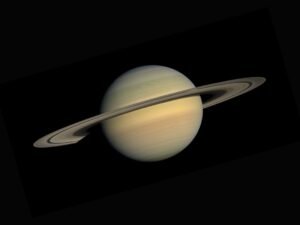The Andromeda Galaxy, also known as Messier 31, M31, or NGC 224, is a spiral galaxy located about 2.537 million light-years from Earth. It is the nearest spiral galaxy to the Milky Way, making it one of the most studied and well-known galaxies in the universe. Andromeda is also the largest galaxy in the Local Group, which is a collection of over 54 galaxies that includes the Milky Way, the Triangulum Galaxy, and numerous dwarf galaxies.
Andromeda is visible to the naked eye from Earth and has been observed and studied for centuries. Its name comes from the princess Andromeda in Greek mythology, and it is often referred to as the Andromeda Nebula due to its appearance in the night sky. The galaxy spans approximately 220,000 light-years in diameter, making it significantly larger than the Milky Way. Andromeda is home to over a trillion stars, as well as a vast amount of gas, dust, and dark matter. Its sheer size and proximity make it a fascinating subject of study for astronomers and astrophysicists around the world.
Key Takeaways
- The Andromeda Galaxy is the closest spiral galaxy to the Milky Way and is home to over a trillion stars.
- Exploration of the Andromeda Galaxy began in the 10th century and has continued through modern telescopes and space probes.
- The planets in the Andromeda Galaxy are similar to those in the Milky Way, with some potentially habitable exoplanets.
- The potential for life in the Andromeda Galaxy is still uncertain, but the discovery of habitable exoplanets is a promising sign.
- Space travel to the Andromeda Galaxy presents numerous challenges, including the vast distance and the need for advanced propulsion systems.
History of Exploration
The exploration of the Andromeda Galaxy dates back to ancient times when it was first observed by astronomers and philosophers. The Persian astronomer, Abd al-Rahman al-Sufi, was the first to document the galaxy in his Book of Fixed Stars in 964 AD. However, it wasn’t until the 20th century that significant advancements in technology allowed for more detailed observations and studies of Andromeda.
In 1923, American astronomer Edwin Hubble discovered Cepheid variable stars in Andromeda, which allowed him to calculate its distance from Earth and confirm that it was a separate galaxy. This discovery revolutionized our understanding of the universe and paved the way for further exploration of Andromeda and other galaxies. Since then, numerous telescopes and space missions have been dedicated to studying Andromeda, including the Hubble Space Telescope, the Spitzer Space Telescope, and the upcoming James Webb Space Telescope.
The history of exploration of Andromeda has provided invaluable insights into the nature of galaxies, the evolution of stars, and the structure of the universe. It has also inspired countless scientists and researchers to continue pushing the boundaries of our knowledge and understanding of the cosmos.
Characteristics of Andromeda Galaxy’s Planets
The Andromeda Galaxy is home to a diverse array of planets, stars, and other celestial bodies. While much of our knowledge about these planets is based on observations and simulations, scientists have been able to make some educated guesses about their characteristics based on what we know about planetary formation and the conditions within Andromeda.
One of the most intriguing aspects of Andromeda’s planets is their potential diversity. Given the size and complexity of the galaxy, it is likely that there are a wide variety of planetary environments within Andromeda. This could include rocky terrestrial planets similar to Earth, gas giants like Jupiter and Saturn, as well as exotic worlds with conditions unlike anything we have seen in our own solar system.
Another important characteristic of Andromeda’s planets is their potential for habitability. While we have yet to discover any definitive evidence of life beyond Earth, the sheer number of planets within Andromeda increases the likelihood that some may have conditions suitable for life as we know it. This has led to increased interest in studying Andromeda’s planets and searching for signs of habitability or even extraterrestrial life.
Potential for Life
| Planet | Distance from Sun (AU) | Atmosphere Composition | Surface Temperature (°C) |
|---|---|---|---|
| Earth | 1 | Nitrogen, Oxygen | 15 |
| Mars | 1.52 | Carbon Dioxide | -65 |
| Europa (moon of Jupiter) | 5.2 | Oxygen | -160 |
The potential for life within the Andromeda Galaxy is a topic of great interest and speculation among scientists and enthusiasts alike. While we have yet to discover any concrete evidence of extraterrestrial life within Andromeda, the sheer size and diversity of the galaxy make it an intriguing candidate for harboring life beyond Earth.
One factor that contributes to the potential for life within Andromeda is the presence of habitable zones around stars. These are regions where conditions are conducive to liquid water, which is considered a key ingredient for life as we know it. Given the vast number of stars within Andromeda, it is likely that there are numerous habitable zones throughout the galaxy, increasing the likelihood of finding potentially habitable planets.
Another factor that contributes to the potential for life within Andromeda is the presence of organic molecules and building blocks of life. Studies have shown that these essential components can be found in various regions within the galaxy, suggesting that the raw materials for life may be abundant in Andromeda.
While we have yet to discover any definitive evidence of life within Andromeda, ongoing research and future space missions may provide us with new insights into this tantalizing possibility.
Challenges of Space Travel to Andromeda Galaxy
The prospect of traveling to the Andromeda Galaxy presents numerous challenges that make it an incredibly daunting endeavor. The sheer distance between our solar system and Andromeda – approximately 2.537 million light-years – makes it currently impossible for any human-made spacecraft to reach the galaxy within a reasonable timeframe.
One of the primary challenges of space travel to Andromeda is overcoming the limitations imposed by our current propulsion technology. Even with our most advanced spacecraft and propulsion systems, it would take tens of thousands of years to reach Andromeda using conventional methods. This makes it necessary to develop new propulsion technologies that can enable faster-than-light travel or significantly reduce travel times over intergalactic distances.
Another significant challenge of space travel to Andromeda is ensuring the safety and well-being of astronauts during such a long journey. The physical and psychological effects of prolonged space travel are not fully understood, and it would be necessary to develop new technologies and strategies to mitigate these risks over such vast distances.
Despite these challenges, there is ongoing research and speculation about potential methods for intergalactic travel, including concepts such as warp drives, wormholes, and other theoretical propulsion systems. While these ideas remain firmly in the realm of science fiction for now, they represent exciting possibilities for future exploration beyond our own galaxy.
Future Missions and Discoveries

Despite the immense challenges associated with traveling to Andromeda, there are ongoing efforts to study and explore the galaxy using telescopes, space probes, and other advanced technologies. The upcoming James Webb Space Telescope, set to launch in 2021, is expected to provide unprecedented insights into Andromeda’s structure, composition, and potential for hosting habitable planets.
In addition to telescopic observations, there are also proposals for future space missions dedicated to studying Andromeda up close. These missions could involve sending robotic probes or spacecraft to conduct detailed surveys of the galaxy’s planets, stars, and other celestial phenomena.
One particularly ambitious proposal is the concept of sending a mission to establish a human presence on a potentially habitable exoplanet within Andromeda. While this idea remains firmly in the realm of speculation for now, it represents an exciting vision for future exploration beyond our own galaxy.
As our understanding of space exploration continues to advance, it is likely that we will see new missions and discoveries that push the boundaries of our knowledge about Andromeda and other galaxies in the universe.
Ethical Considerations in Planetary Exploration
The exploration of the Andromeda Galaxy raises important ethical considerations that must be carefully addressed as we continue to study and potentially interact with other celestial bodies beyond our own solar system.
One key ethical consideration is the potential impact of human exploration on extraterrestrial environments. If we were to discover habitable planets or signs of life within Andromeda, it would be crucial to ensure that any human presence or scientific activities do not disrupt or harm these delicate ecosystems.
Another ethical consideration is the potential consequences of introducing Earth-based organisms or contaminants into extraterrestrial environments. If future missions were to involve sending spacecraft or probes to explore Andromeda’s planets, there would be a risk of inadvertently contaminating these worlds with microorganisms or other biological material from Earth.
Furthermore, there are ethical questions surrounding our interactions with any potential extraterrestrial life forms that may be discovered within Andromeda. It would be essential to approach such discoveries with caution and respect, taking into account the potential impact on these life forms and their ecosystems.
As we continue to explore and study the Andromeda Galaxy, it will be important for scientists, policymakers, and society as a whole to consider these ethical considerations and ensure that our actions are guided by principles of responsible exploration and stewardship of the cosmos.
Discovering planets in the Andromeda Galaxy has always been a fascinating topic, and a recent article on Just Tidings sheds light on the incredible journey of Bridgit Mendler, from Disney star to space startup CEO. Her innovative work in the space industry is pushing the boundaries of space exploration, making it possible for us to learn more about distant galaxies and their planetary systems. It’s truly inspiring to see how individuals like Mendler are contributing to our understanding of the universe. You can read more about her remarkable story here.




















+ There are no comments
Add yours